Subscribe now to get notified about IU Jharkhand journal updates!
Covid-19 pandemic and HDI: Is there any linkage?
Abstract :
It is generally observed and cited that developed countries who are on top of Human Development Index (HDI) list face lesser severity and loss due to any pandemic because of high disposable income, better health and education, good social governance and of course, effective political norms and policy. However, data on Covid-19 pandemic regarding number of cases and deaths show some unusual result and compel us to rethink on the definition of human development as proposed and captured by HDI. UK, Netherlands, USA, Bahrain, Luxemburg. Switzerland, France, Australia etc. are some of the most developed nations having high ranking on HDI but the total Covid cases (per million of population) is comparatively higher (100,000-180,000) than less developed and poor countries like Kazakhstan, Honduras, Thailand, India, Zambia, Kenya, Ghana etc (5,000-50,000). If we look at the death rate, USA, Italy, UK, Russia, France, Luxemburg, Germany, Netherlands, Canada are some of the highly developed nations who have registered higher death rate per million of population (700-2500) than countries low on HDI ranking like Sri Lanka, Belarus, Iraq, Indonesia, Nepal, India, Brunei, Cambodia, Pakistan etc (120-680). Hence, the objective of the research is to explore the relevance of HDI concept in the wake of Covid-19 pandemic. Have the countries on the top of the HDI performed better than countries low on the HDI? Alternatively, have the countries closer on HDI performed equally to deal with Covid-19 cases and the death caused by it? The secondary data is used compiled and provided by 'Centre for Disease Control and prevention' USE. Data on daily basis is taken from 1st Apr 2020 to 28th Dec 2021. ANOVA and regression tools are used for inferential statistics and accordingly, conclusion is made.
Keywords :
Covid-19, HDI, life expectancy, health policy1. Introduction
World is witnessed of Covid-19 pandemic, the most horrific health emergency in world history that has taken more than 5 million lives till now and still counting (worldmeters.info). People of old age group suffered most where death rate is 25 times higher for the age group of 50-64 years and 50 times higher for beyond 64 years (cdc.gov, 2021). In India, the death figure has touched more than 480,000.Almost every country has faced the horrific and dark face of pandemic and still has been doing at their best to contain the pandemic and save the lives. Thanks to early launch of vaccines that has not only saved our life but has also lessen the severity of side effect post-infection recovery. Covid-19 pandemic has compelled us to rethink and reformulate our health and disaster management policy to prepare better in future against any such emergency.
It is generally observed and cited that developed countries who are on top of Human Development Index (HDI) list face lesser severity and loss due to any pandemic because of high disposable income, better health and education, good social governance and of course, effective political norms and policy. However, data on Covid-19 pandemic regarding number of cases and deaths show some unusual result and compel us to rethink on the definition of human development as proposed and captured by HDI. Lets have a look on some facts and figures on Covid-19 cases and deaths compiled by the worldometers referred by American Library Association (ALA).
UK, Netherlands, USA, Bahrain, Luxemburg. Switzerland, France, Australia etc. are some of the most developed nations having high ranking on HDI but the total Covid cases (per million of population) is comparatively higher (100,000-180,000) than less developed and poor countries like Kazakhstan, Honduras, Thailand, India, Zambia, Kenya, Ghana etc (5,000- 50,000). Spread of Covid depends upon several factors including demographic aspect like population density, age distribution, heath status, gathering of people, social cohesion etc; common behavioural aspects regarding sanity, handwash, distancing and awareness of disease; as well as government's policy and approach to contain the spread of disease.HDI lacks several aspects and therefore, it is obvious to have figures of high Covid cases among the top HDI countries.
If we look at the death rate, USA, Italy, UK, Russia, France, Luxemburg, Germany, Netherlands, Canada are some of the highly developed nations who have registered higher death rate per million of population (700-2500) than countries low on HDI ranking like Sri Lanka, Belarus, Iraq, Indonesia, Nepal, India, Brunei, Cambodia, Pakistan etc (120-680) (worldometers.info, 2021). Countries who are high on HDI must have high income per capita for better treatment on health, high education level to ensure better information of Covid symptoms, causes and prevention techniques and of course, better adherence to sanity and distancing norms. Government of those countries are also expected to be proactive in containment of Covid and has started the early drive of vaccination. Then, why the death rate in such developed countries is higher than poor and developing countries. However, it should be noted here that developed countries are not alone on the top of ranking on death per million. Countries like Montenegro, Gibraltar, Croatia, Hungry etc are even higher on ranking but the name of such developed countries in top 25-30 on the list of death per million due to Covid is a major concern and thus, provide an area of research to explore the insights on major causes.
Research Objective
The objective of the research is to explore the relevance of HDI concept in the wake of Covid-19 pandemic. Have the countries on the top of the HDI performed better than countries low on the HDI? Alternatively, have the countries closer on HDI performed equally to deal with Covid-19 cases and the death caused by it? The answer of such questions would help to interlink the HDI attributed to a country with its performance during the pandemic. The finding would explore whether the general concept and understanding of HDI would also valid in any exigency or countries behave and treat differently to deal with emergency situation by going beyond their general assumptions of wealth, health and education status. Such findings would help to rethink on the HDI and provide a basic empirical foundation of constructing a more refined and well-articulated human development metrics.
Literature Review
With the onset of Covid-19 pandemic, the data on number of fresh cases, death counts and the vaccination efforts have been collected. Data have also been collected on the available health resources and their efficiency level, effectiveness of health protocol, lack of other resources and of course,the preparedness level of respective countries. Such a huge global data collected for a long time have provided immense opportunity to study and research and the human development through the lens of pandemic. Findings of the studies at the cross section of socio-economic and demographic status have explored many harsh realities that were earthen under the fancy words of globalization, development, technology and digitization. Such findings have put up a big question marks on our understanding of real development. Few of the empirical studies are discussed here below.
Mittal and Mishra (2020) study the covid related cases and deaths of both developed and developing countries and find that though countries like Sweden, Germany, Italy, UK and US rank very high on the HDI and have also the high life expectancy, they are worst affected by the Covid-19 pandemic. South Korea and New Zealand are exceptions of this finding. Both have also high life expectancy and rank on top of the HDI but the case of infection and deaths are low. Further, the most contrasting result come from the developing countries like India, Vietnam and South Africa where there is moderate life expectancy but these countries have kept the infection and death rate at the lowest in the world.
Troumbis(2021) studies both the developed and developing nations for their preparedness and dealing with Covid-19 pandemic and found that many countries of the high HDI group (ie, values 0.800-0.955), especially in North America and Europe are no longer significantly different from the countries of low HDI and worst performer in dealing COVID-19.
Khazaei, et al (2020) study the prevalence and spread of Covid-19 cases across different countries till 30th April 2020 and investigate the trend of incidence in relation of HDI. The result shows that highest number of Covid-19 cases are reported in United State followed by Spain, Italy, UK and Germany. All these countries are on the top of HDI scale and hence, the authors conclude a positive correlation between the spread of Covid-19 and the HDI.
Mohamed, et al (2021) study 173 countries during the pandemic. They use Poisson Regression Model to identify the relationship between the HDI and pandemic mortality and recovery rate. Their study reveals positive correlation between the HDI and recovery rate that is reflective to the preparedness level of country. HDI is also proved to be positively correlated with mortality rate. Hence, they suggest to understand the connection between socio-economic factors and readiness of preparedness for future pandemic in order to strengthen the healthcare system. The burden of pandemic is also variable among the middle- and high-income countries due to difference in socio-economic inequalities, fragmentation of health system and difference in governance of pandemic.
Yaseefa, et al (2022) also find in their study that countries and region with high HDI have high cases and deaths per million population due to Covid-19. Authors suggested the major causes of such positive correlation are international connectedness and mobility due to trade and tourism, vulnerability of order population and higher rate of non-communicable disease.
In contrast of above findings, Georgiou (2021) find a positive correlation between the HDI and preparedness of countries against the Covid-19. His finding is based on the data of infection cases and death in European countries only. So, according to the author, high HDI countries have performed well in containing the pandemic. The mean education level and the existing health infrastructure are two major factors for their good performance.
Research Methodology
Most of the empirical studies have concluded a positive correlation between the HDI and cases and deaths caused by the Covid-19 pandemic. Studies are conducted in different time periods with different set of countries. Our study is conducted for the period of April 2020 to Dec 2021. it is the period during which the Covid-19 pandemic reached at the peak, twice in most of the countries. Second, vaccination also gets started and by the end of year 2021, a significant part of the population gets fully vaccinatd. Thus,the country's performance on dealing with cases and deaths at the base factor of HDI would be interesting to explore.
Secondary data is used here that is compiled and provided by 'Centre for Disease Control and prevention' USA. Country wise data on Covid cases, deaths, vaccination and other aspects are available. Our part of data contains - 'Total Covid cases per million', 'Total deaths per million', 'Stringency Index', 'Population Density', Median age', 'GDP per capita', 'Hospitalization beds per thousands', 'life expectancy' and 'Human Development Index'. Data on daily basis is taken from 1st Apr 2020 to 28th Dec 2021.
Data has been taken into three group Group 1 of low HDI countries, group 2 of middle HDI countries and Group 3 of high HDI countries. Each group has 5 countries of closer HDI and for each country, the variables are taken as discussed above. Countries in each group with respective HDI are as follows-
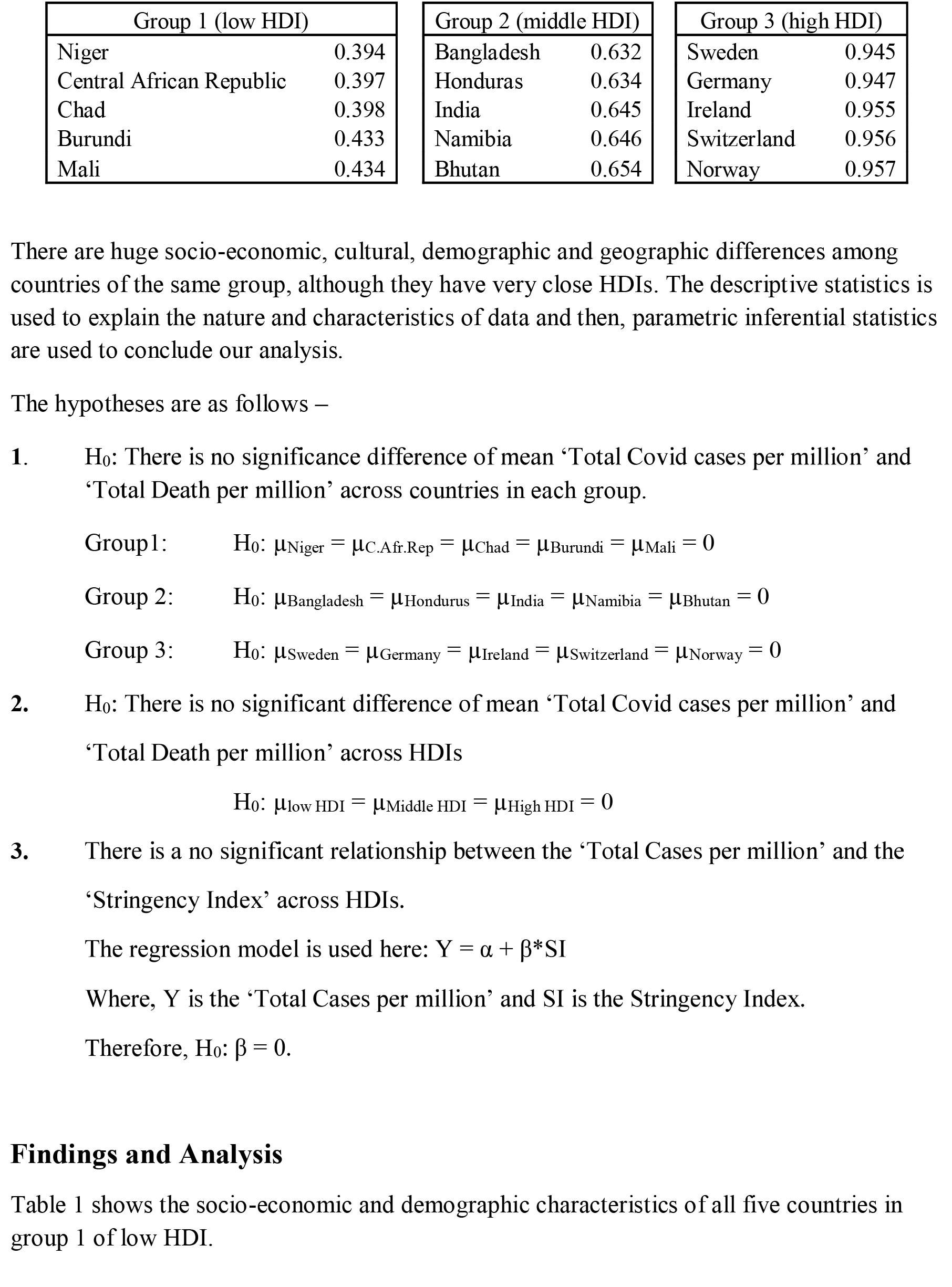
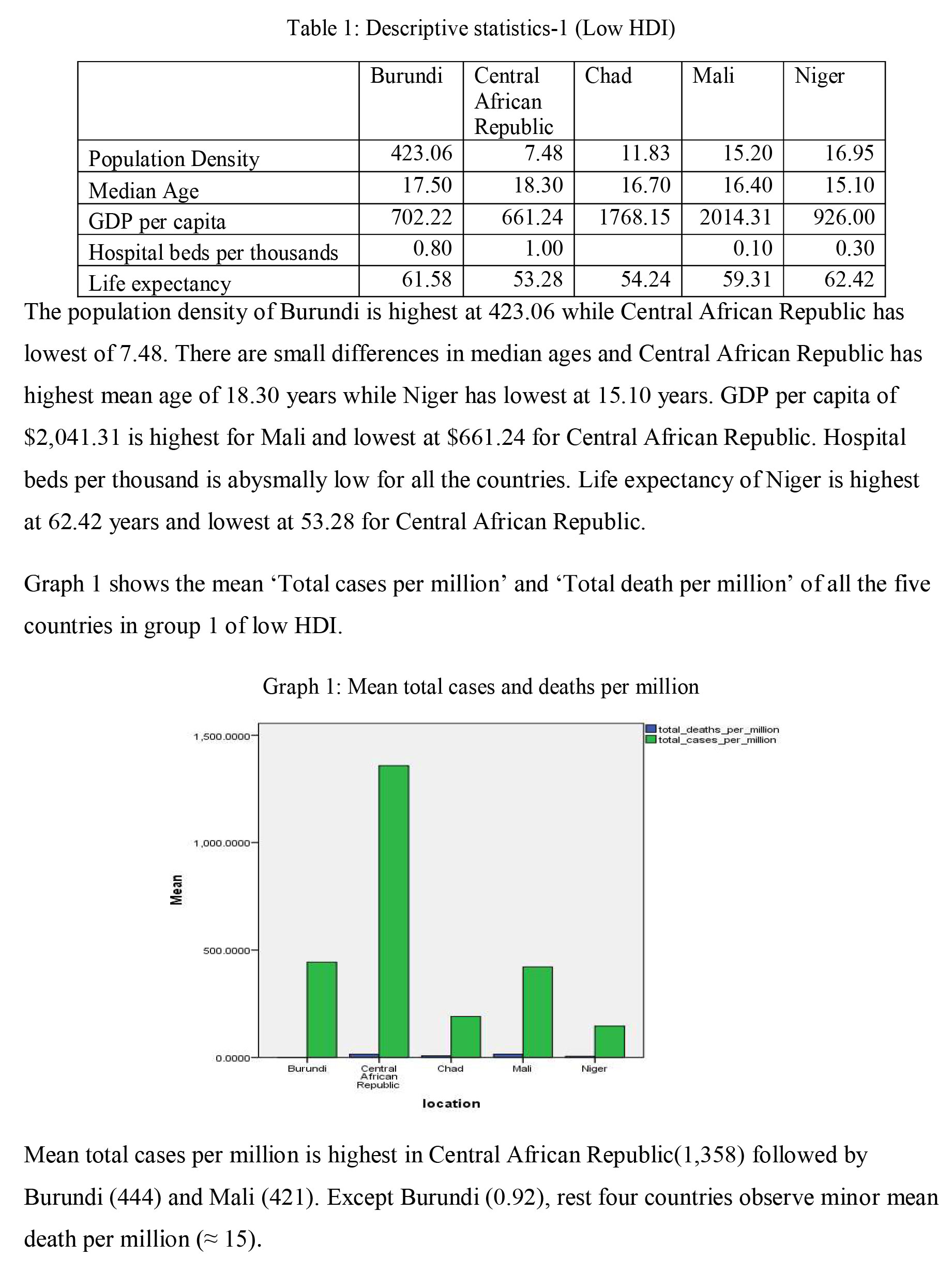
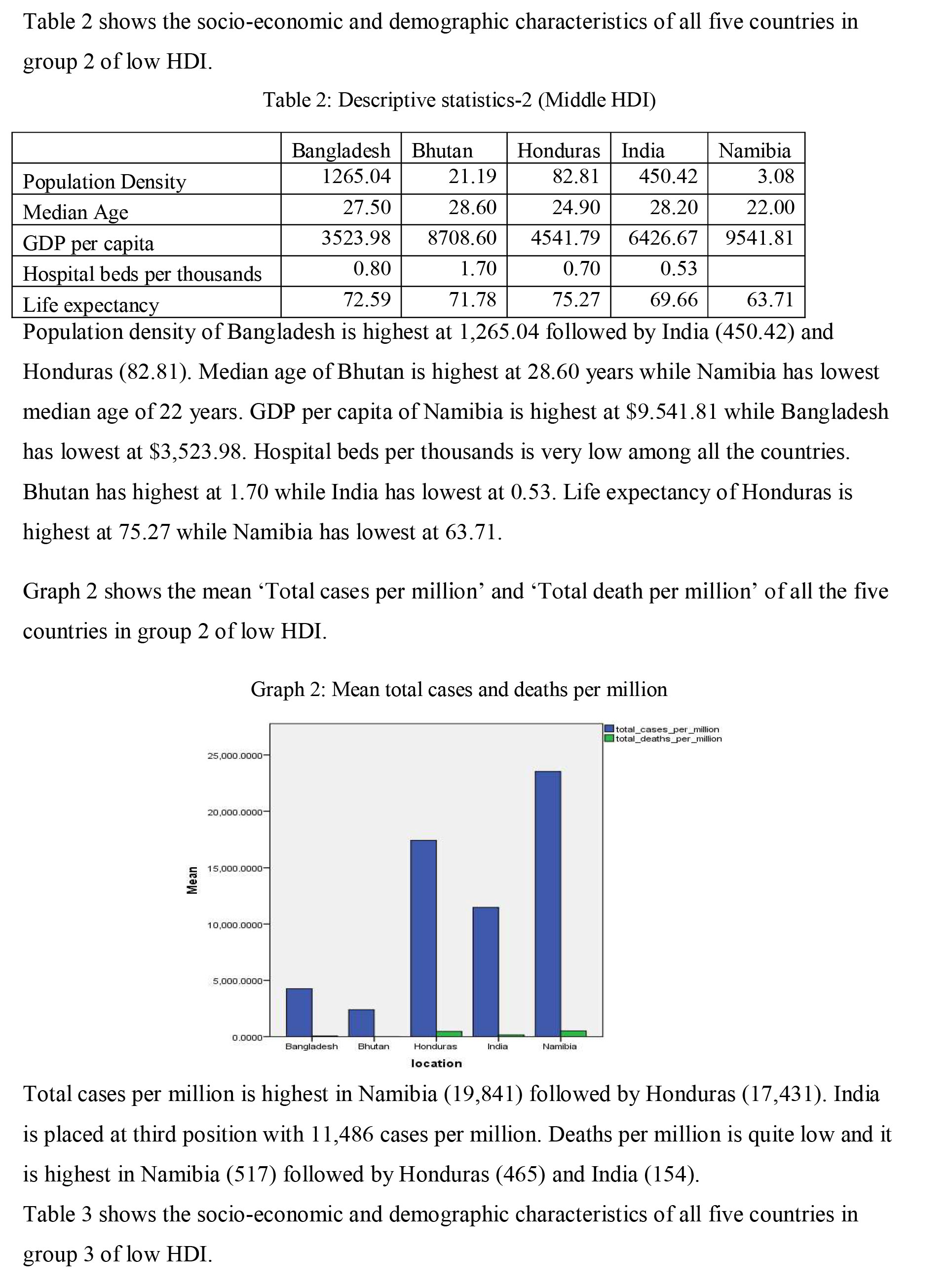
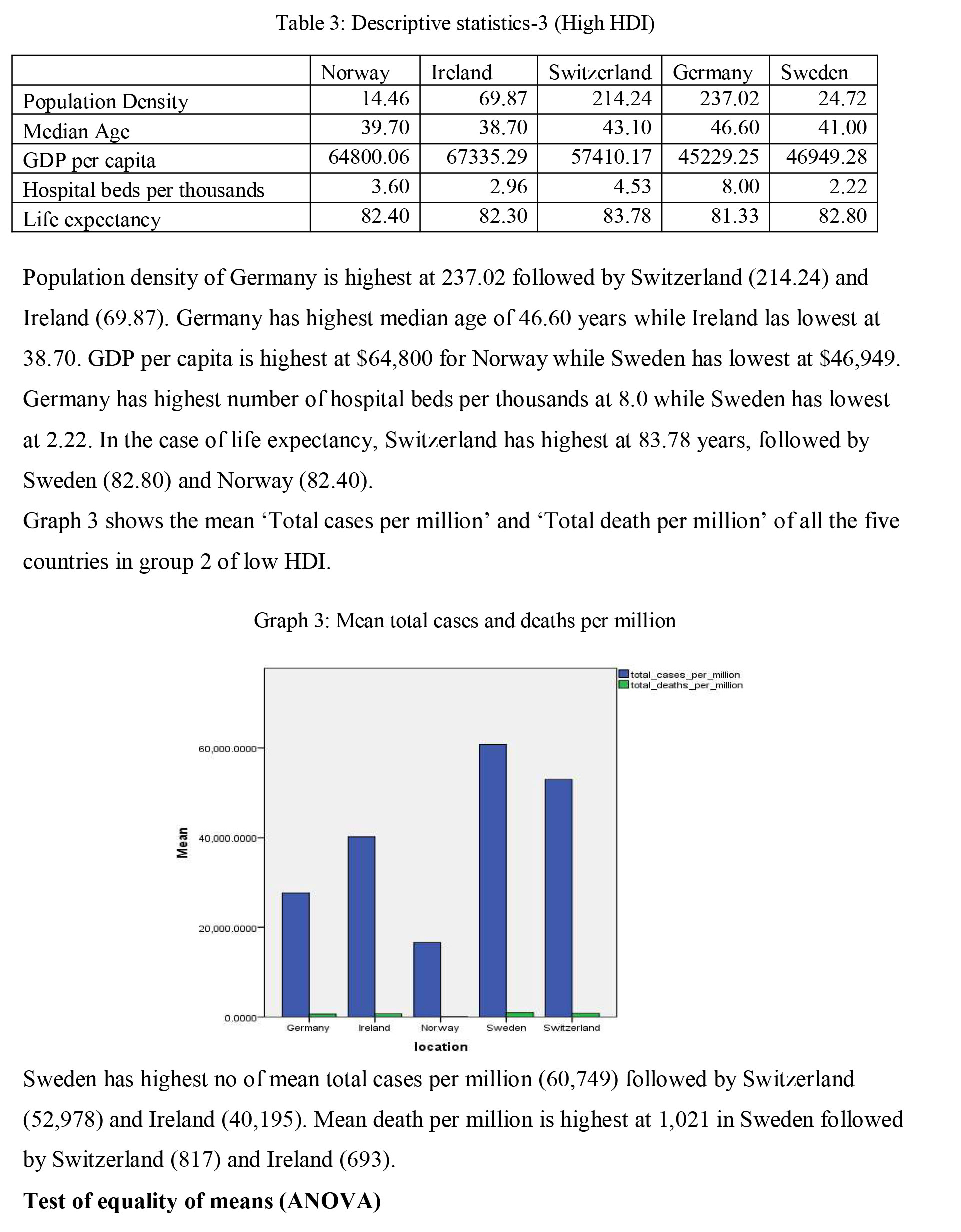
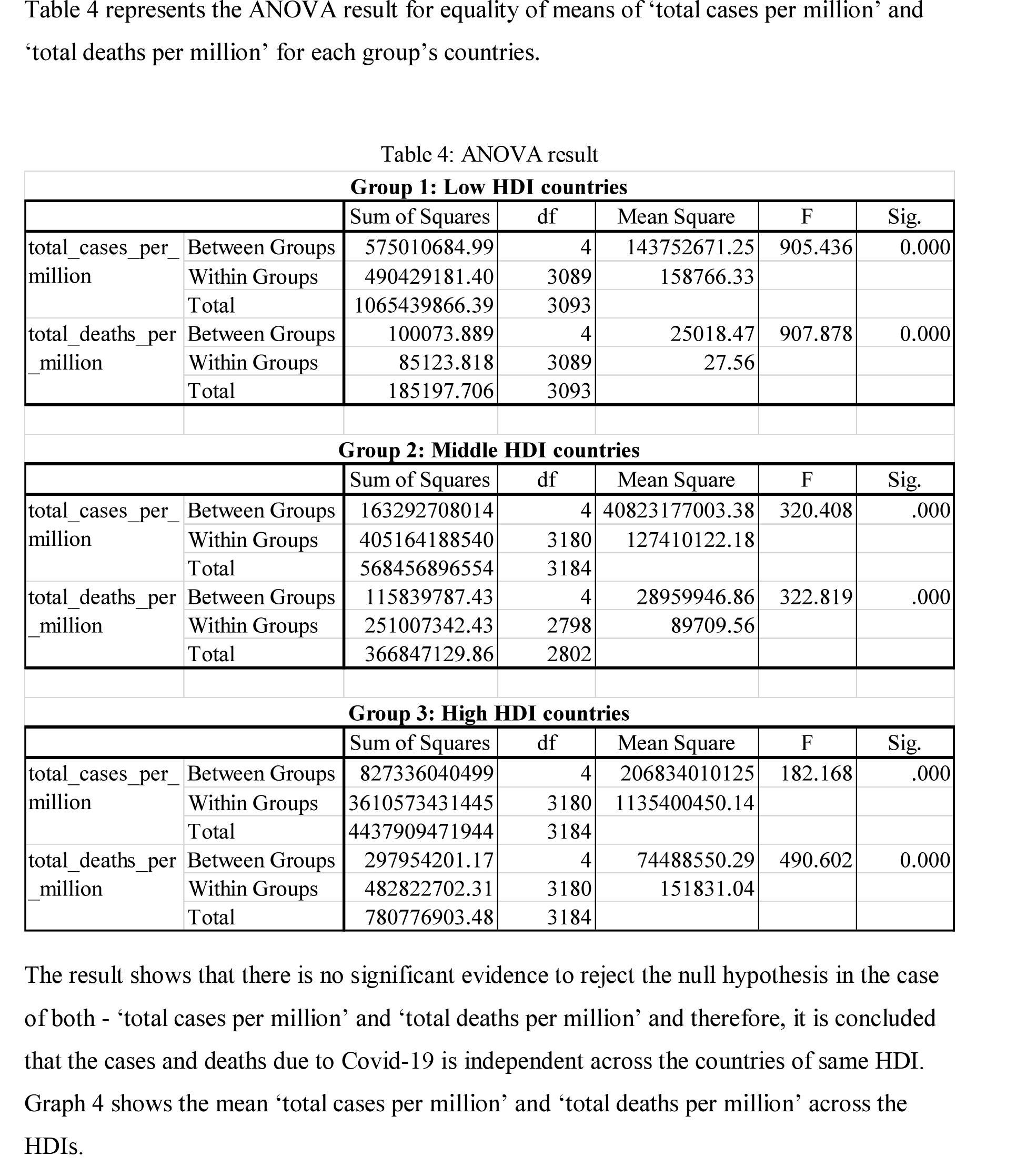
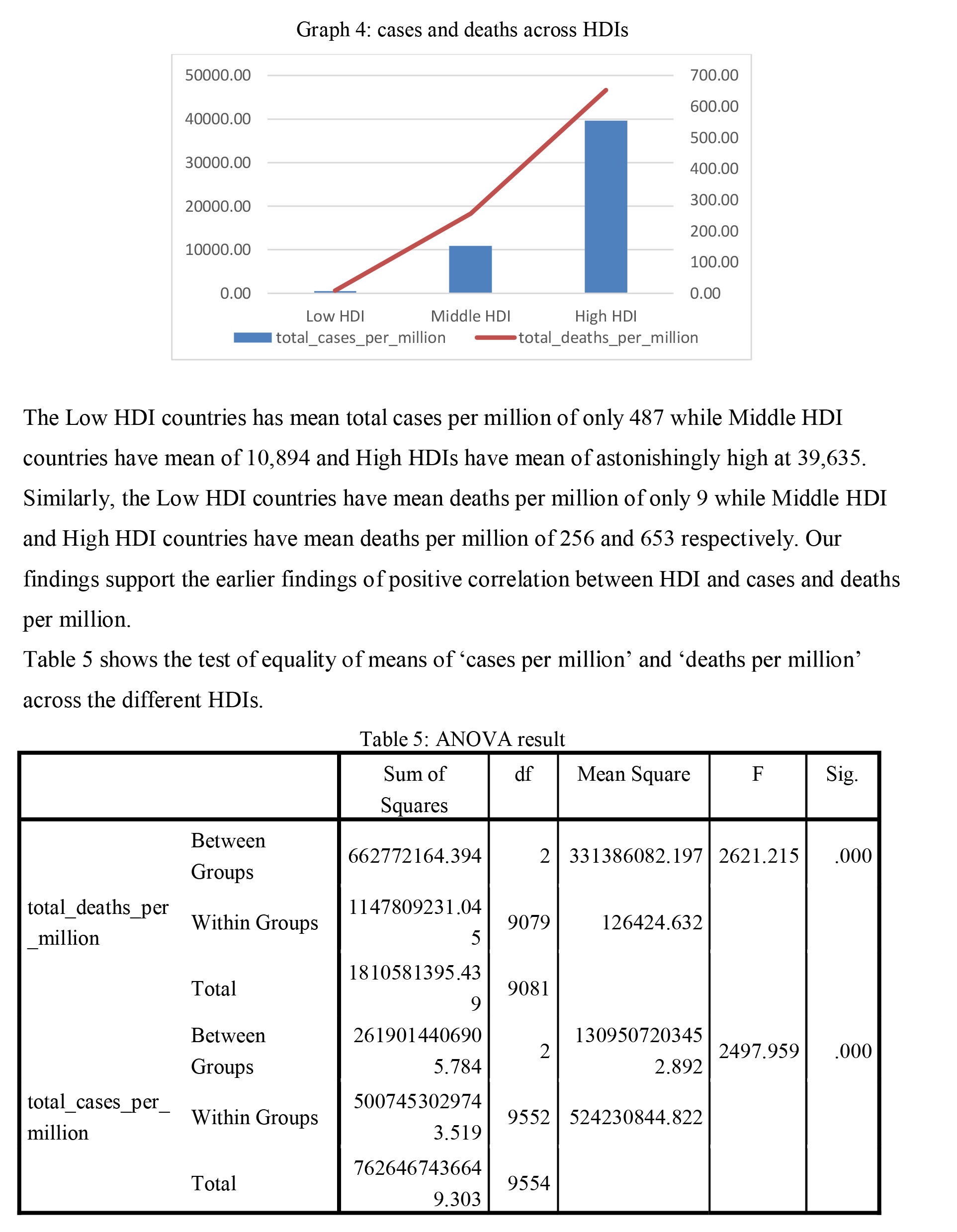
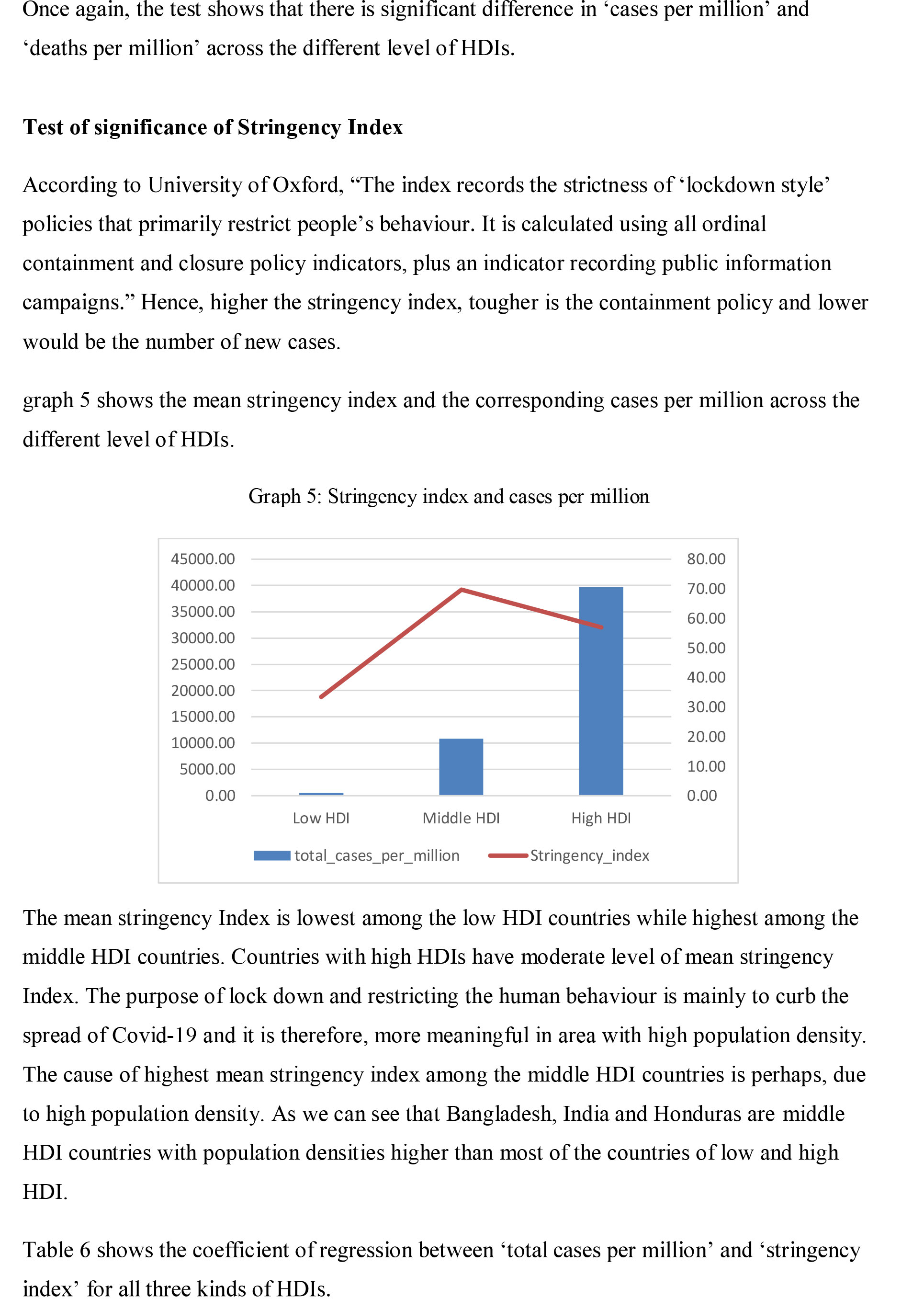

The t statistics of Stringency indices for all three HDIs are 0.000, lower than 0.05 and hence, it is concluded that there is significance inverse relationship between the 'cases per million' and the 'stringency index. Furthur, the coefficient of stringency index is highest at -0.384, we can conclude that Middle HDI countries have tougher lockdown policy than others.
Conclusion
The analysis suggests that countries with closer HDIs have different status of 'total cases per million' and 'death per million'. Even, across the lower to higher HDI countries, the situation gets worst and the high developed nations like Germany, Sweden, Norway etc reported higher number of cases and death in comparison to low HDI countries. Therefore, it is concluded that HDI doesn't reflect the true meaning of developed nation in the case of any pandemic and even, negative correlation is found between HDI and outcome of pandemic. High HDI countries, so called the developed nations are proved to be worst performers in handling and curbing such menace. The result of the analysis suggests few important things. First, the efficency of health facilities and infrastructure in normal condition can't be expected equally during the pandemic also. Pandemic is entirely different health emergency where the best of the facilities is tested to the extreme level. Second, due to good health facility people ignores the disease and takes the health system for granted. Such behaviour perpetuates the adverse outcome of the disease to the unmanageable level. Thirds, excessive privatisation of health facilities and ignoring the public services like food, shelter, public health infrastructure etc takes a toll during such pandemic. Fourth, the active intervention of government is also proved to be very effective during such pandemic. Finally, it is the demographic and cultural factors that play a decisive role in handling and curbing the pandemic.
The Covid-19 pandemic has brought all the countries whether it is developed, developing or poor one on the same footing of health emergency and finding the way of recovery. Developed and rich countries are not better off in handling and coping out of such pandemic. Even, those countries have lost more human lives than lower one. Thus, Pandemic and natural calamities treat all equally. Therefore, future planning, policy formulation and resource distribution should be done by taking all on the board equally rather than adopting skewed approach based on GDP or HDI. Such holistic approach is imperative for preparing ourselves against other pandemic and the current threat of global warming because nature doesn't differentiate between the rich and the poor. we need to rethink on the current development indicator HDI.
References
Covid statistics (2021). Retrieved from: https://www.worldometers.info/coronavirus/
Data on Covid cases (2021). Retrieved from:https://www.cdc.gov/coronavirus/2019- ncov/covid-data/investigations-discovery/hospitalization-death-by-age.html
Covid cases updates (2021). Retrieved from: https://www.cdc.gov/coronavirus/2019- ncov/cases-updates/index.html
Troumbis AY (2021). Testing the socioeconomic determinants of COVID-19 pandemic hypothesis with aggregated Human Development Index. J Epidemiol Community Health, Vol.75, pp. 414-415. Retrieved from: https://jech.bmj.com/content/75/4/414
Khazaei, et al (2020). COVID-19 Pandemic in the World and its Relation to Human Development Index: A Global Study. Archives of Clinical Infectious Diseases. Retrieved from: https://www.researchgate.net/publication/343683780_COVID- 19_Pandemic_in_the_World_and_its_Relation_to_Human_Development_Index_A_Global_ Study
Georgiou, N (2021). Is Human Development Index a Shield against COVID-19? Retrieved from: https://ssrn.com/abstract=3834206
Mohamed, et al (2021). The association between the initial outcomes of COVID-19 and the human development index: An ecological study. Human System Management. pp.1 11.
Retrieved from: https://content.iospress.com/articles/human-systems- management/hsm210005
